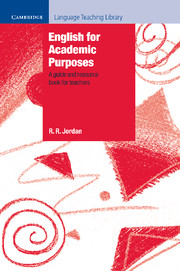Book contents
- Frontmatter
- Contents
- List of figures
- List of abbreviations
- Acknowledgements
- Introduction
- Part I English for Academic Purposes and study skills
- Part II Study skills and practice (EGAP)
- Part III English for Specific Academic Purposes
- Appendices
- 1 Recommended books and journals
- 2 Educational technology
- 3 BALEAP, and the Survey
- 4 EAP exams and examining bodies
- References
- Subject index
- Author index
3 - BALEAP, and the Survey
Published online by Cambridge University Press: 10 November 2010
- Frontmatter
- Contents
- List of figures
- List of abbreviations
- Acknowledgements
- Introduction
- Part I English for Academic Purposes and study skills
- Part II Study skills and practice (EGAP)
- Part III English for Specific Academic Purposes
- Appendices
- 1 Recommended books and journals
- 2 Educational technology
- 3 BALEAP, and the Survey
- 4 EAP exams and examining bodies
- References
- Subject index
- Author index
Summary
BALEAP was founded in 1972. Initially, it was known as SELMOUS (The Group for ‘Special English Language Materials for Overseas University Students’). The name reflected the main priority at the time, which was to produce appropriate teaching materials. In 1989 the name was changed to BALEAP, in order to indicate the reduction in emphasis on materials and the increase in professionalism of member institutions on a broader front. This entails not only high standards of teaching on EAP courses, but also research, and adequate administrative and pastoral procedures. Membership is open to British university departments which provide courses in EAP for overseas students. The current membership is more than 60 British universities.
Members of BALEAP subscribe to a Code of Practice which sets standards for courses in EAP/study skills. Since 1991 BALEAP has operated an Accreditation Scheme whereby members' courses are visited by assessors. The Scheme is recognised by the British Council, which is represented on the Accreditation Scheme Committee (BASC). A full account of the Scheme is contained in an article by June O'Brien (EAP Course Evaluation and Quality Assurance) in Evaluation and Course Design in EAP, edited by M. Hewings and T. Dudley-Evans, Review of ELT, 6(1). Phoenix ELT, 1996. The Code of Practice is described by C. Weir and J. Roberts in Evaluation in ELT, Blackwell, 1994 (in Appendix 4.1, which lists the criteria for assessment, together with a checklist of the necessary documentation).
- Type
- Chapter
- Information
- English for Academic PurposesA Guide and Resource Book for Teachers, pp. 359 - 361Publisher: Cambridge University PressPrint publication year: 1997



